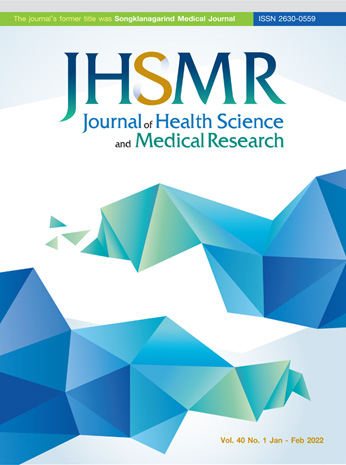Risk Factors of Postoperative Shivering at Post Anesthesia Care Unit in Normothermic Patients Underwent General Anesthesia
DOI:
https://doi.org/10.31584/jhsmr.2021816Keywords:
general anesthesia, normothermic patient, postoperative shivering, risk factorsAbstract
Objective: The aim of study was to identify risk factors that can be modified to reduce incidence of postoperative shivering in normothermic patient who underwent general anesthesia.
Material and Methods: A retrospective case control study was conducted between January 2017 and August 2018 by assessing the anesthetic records of normothermic patients at a post anesthesia care unit who underwent general anesthesia. A control group of 201 patients was randomly matched with 201 cases by age ( 5 years) and site of surgery. Medical records were reviewed for data including patient demographics, operative time, anesthetic medication, type of fluid, core temperature at the end of surgery and occurrence of postoperative shivering. Conditional logistic regression analysis was performed to assess the association between potential risk factors and postoperative shivering.
Results: Higher body mass index (BMI) [odds ratio (OR) 0.91, 95% confidence interval (CI) 0.87-0.96] and higher core temperature at end of surgery (OR 0.33 95% CI 0.18-0.63) are associated with reduced risk of postoperative shivering. Whereas emergency case compared with elective case (OR 3.06 95% CI 1.63-5.72) and longer duration every 10 minutes (OR 1.05 95% CI 1.03-1.08) are associated with an increased risk of postoperative shivering.
Conclusion: Emergency case, longer duration of surgery, lower BMI and lower core temperature at end of surgery were significantly associated with postoperative shivering.
References
Park SM, Mangat HS, Berger K, Rosengart AJ. Efficacy spectrum of antishivering medications: meta-analysis of randomized controlled trials. Crit Care Med 2012;40:3070-82.
Crossley AW. Peri-operative shivering. Anaesthesia 1992;47: 193-5.
Hoshijima H, Takeuchi R, Kuratani N, Nishizawa S, Denawa Y, Shiga T, et al. Incidence of postoperative shivering comparing remifentanil with other opioids: a meta-analysis. J Clin Anesth 2016;32:300-12.
Eberhart LH, D derlein F, Eisenhardt G, Kranke P, Sessler DI, Torossian A, et al. Independent risk factors for postoperative shivering. Anesth Analg 2005;101:1849-57.
Tsukamoto M, Hitosugi T, Esaki K, Yokoyama T. Risk factors for postoperative shivering after oral and maxillofacial surgery. J Oral Maxillofac Surg 2016;74:2359-62.
Crossley AW. Six months of shivering in a district general hospital. Anaesthesia 1992;47:845-8.
Witte JD, Sessler DI. Perioperative shivering: physiology and pharmacology. Anesthesiology 2002;96:467-84.
zer AB, Altun AY, Erhan L, atak T, Karatepe , Demirel İ, et al. The effect of body mass index on perioperative thermoregulation. Ther Clin Risk Manag 2016;12:1717-20.
Frank SM, Kluger MJ, Kunkel SL. Elevated thermostatic setpoint in postoperative patients. Anesthesiology 2000;93: 1426-31.
Downloads
Published
How to Cite
Issue
Section
License

This work is licensed under a Creative Commons Attribution-NonCommercial-NoDerivatives 4.0 International License.
























